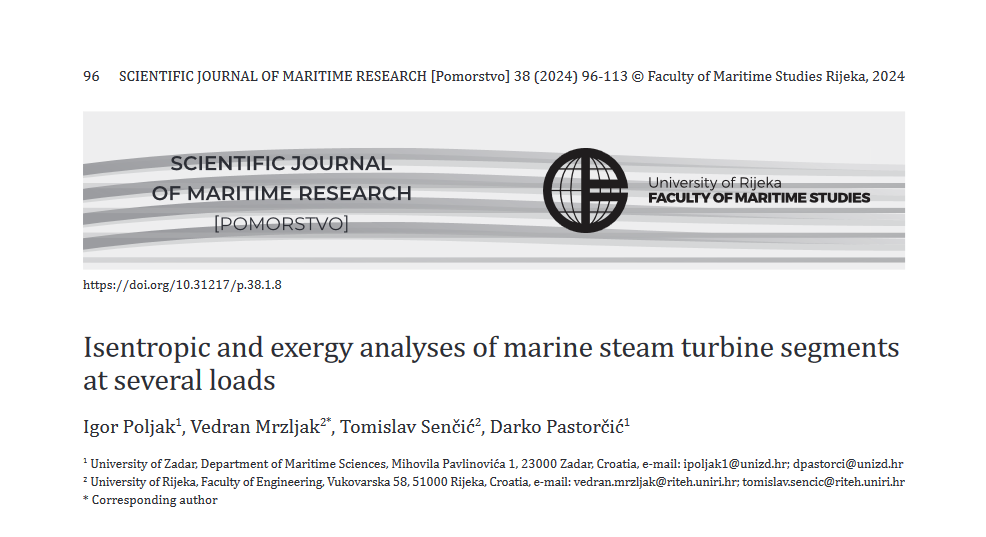Isentropic and exergy analyses of marine steam turbine segments at several loads
Keywords:
marine steam turbine, turbine segments, isentropic analysis, exergy analysis, the ambient temperature variation, various loadsAbstract
This research presents isentropic and exergy analyses of marine steam turbine segments at three loads. Turbine segment is a part of any cylinder which is placed between the steam entrance to the cylinder and first steam extraction, between steam extractions and finally between last steam extraction and steam exit from the cylinder. Division of each cylinder to the segments allows insight into the various cylinder parts operation and an observation is the cylinder properly balanced. The analyzed marine steam turbine is composed of two cylinders – High Pressure Cylinder (HPC) and Low Pressure Cylinder (LPC), while each cylinder has two segments. The dominant part of real mechanical power produced in HPC is actually produced in the first HPC part (segment 1), while in LPC, the dominant part of real mechanical power is produced in the last LPC part (segment 4). Segments 1 and 3 have the highest improvement potential (inlet segments of both HPC and LPC) due to the highest isentropic losses and exergy destructions. HPC is much better balanced cylinder because along with isentropic, also exergy efficiencies between its segments (segment 1 and segment 2) at all loads differ lower than 7%, while the same cannot be stated for the LPC which exergy efficiencies between segments (segment 3 and segment 4) at all loads differ more than 20%. Very low isentropic and exergy efficiencies of the segment 3, at all observed loads, indicate that this turbine segment is highly problematic and at least some of the turbine stages mounted in this segment have difficulties in operation or potential malfunction. In addition, segment 3 is also the highest influenced by the ambient temperature change in comparison to other segments. The ambient temperature increase from 5 °C up to 45 °C can decrease segment exergy efficiency between 1.31% and 3.17%, if all the segments and all loads of the analyzed marine steam turbine are observed.

Downloads
Published
Issue
Section
License
Copyright (c) 2024 Igor Poljak, Vedran Mrzljak, Tomislav Senčić, Darko Pastorčić

This work is licensed under a Creative Commons Attribution-NonCommercial-NoDerivatives 4.0 International License.
Scientific Journal of Maritime Research understands the need for authors to disseminate and maximize the impact of their research. When submitting an article for publishing in Scientific Journal of Maritime Research, it implies that the Corresponding Author transfers, with the consent of all Coauthors, the copyright ownership in the referenced submission, including all versions in any format now known or hereafter developed, to the Scientific Journal of Maritime Research.
Copyright protects your original work and research material and prevents others from using it without your permission. Others will be required to credit you and your work properly, thus increasing its impact. Should your submission be rejected or withdrawn prior to acceptance for publication by Scientific Journal of Maritime Research, this transfer will be null and void.
Authors, users or readers of an article need clear instructions on how they can use the article. Scientific Journal of Maritime Research uses the Creative Commons Attribution-NonCommercial-NoDerivatives (CC-BY-NC-ND) 4.0 International License, which governs the use, publishing and distribution of articles by authors, publishers and the wider general public.
The authors are allowed to post a digital file of the published article, or the link to the published article (Scientific Journal of Maritime Research web page) may be made publicly available on websites or repositories, such as the Author’s personal website, preprint servers, university networks or primary employer’s institutional websites, third party institutional or subject-based repositories, and conference websites that feature presentations by the Author(s) based on the published article, under the condition that the article is posted in its unaltered Scientific Journal of Maritime Research form, exclusively for non-commercial purposes.




